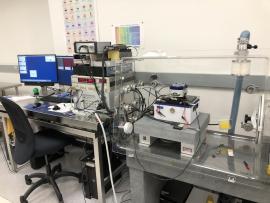Asylum AFM (afm-asylum)
Overview

Asylum AFM MFP-3D is a fully-featured atomic force microscopy system. It can accommodate a variety of small-to-medium size samples that do not exceed ~5-6 mm in height. The microscope is compatible with standard AFM probes and is capable of operating in a number of configuration modes, including (but not limited to): Contact mode Tapping (AC) mode EFM/MFM (electrostatic/magnetic force) mode Mechanical mapping (force-distance spectroscopy) SKPM (Kelvin probe) mode ORCA (conductive) mode Lithography and anodic oxidation mode PFM (piezoresponse) mode SThM (scanning thermal) mode The AFM has manual approach system and manual sample translation with ~5mm range in each direction. The maximum XY piezo scanner range is 120 µm and the maximum Z piezo range is 15 µm. In addition, the microscope is located inside a simple glovebox enclosure, capable of maintaining inert argon atmosphere down to ~10-20 PPM oxygen.
Cleanliness:
Processing Technique(s)
Capabilities and Specifications
Substrate Sizes
Lab Facility, Location, and NEMO Information
Lab Facility:
Location:
NEMO Area (ExFab by room):
NEMO ID:
afm-asylum
Training and Maintenance

Lab Facility:
Training Charges:
4.00 hours
Primary Trainer:
Backup Trainer(s):
Primary Maintenance:
Backup Maintenance:
Steps to become a tool user
-
Become a member of SNF.
- Please send an email to nano-spmstaff@lists.stanford.edu to sign up for training.
- Watch videos linked here (SunetID login required)
- Attend General/group training. It includes an overview of the AFM principles, overview of the instrument, and all basic aspects of its operation. You do not need to bring any samples to the group training but you might want to print your own copy of the manual to take notes on. The group training is limited to a maximum of 3 participants and can be requested by contacting the primary trainer.
- Attend and pass one-on-one qualification. In this session the user demonstrates that they can safely and effectively operate the tool on their own sample and without the need for assistance from the trainer. The qualification is limited to 1 person only and can be scheduled sometime after the group training, usually within a few weeks. You should bring your notes, a sample, and an AFM probe (purchased either form the stockroom or independently).
- (Optional) Contact the primary trainer to request additional training for any of the advanced modes, such as SKPM, ORCA, SThM, or glovebox operation.


